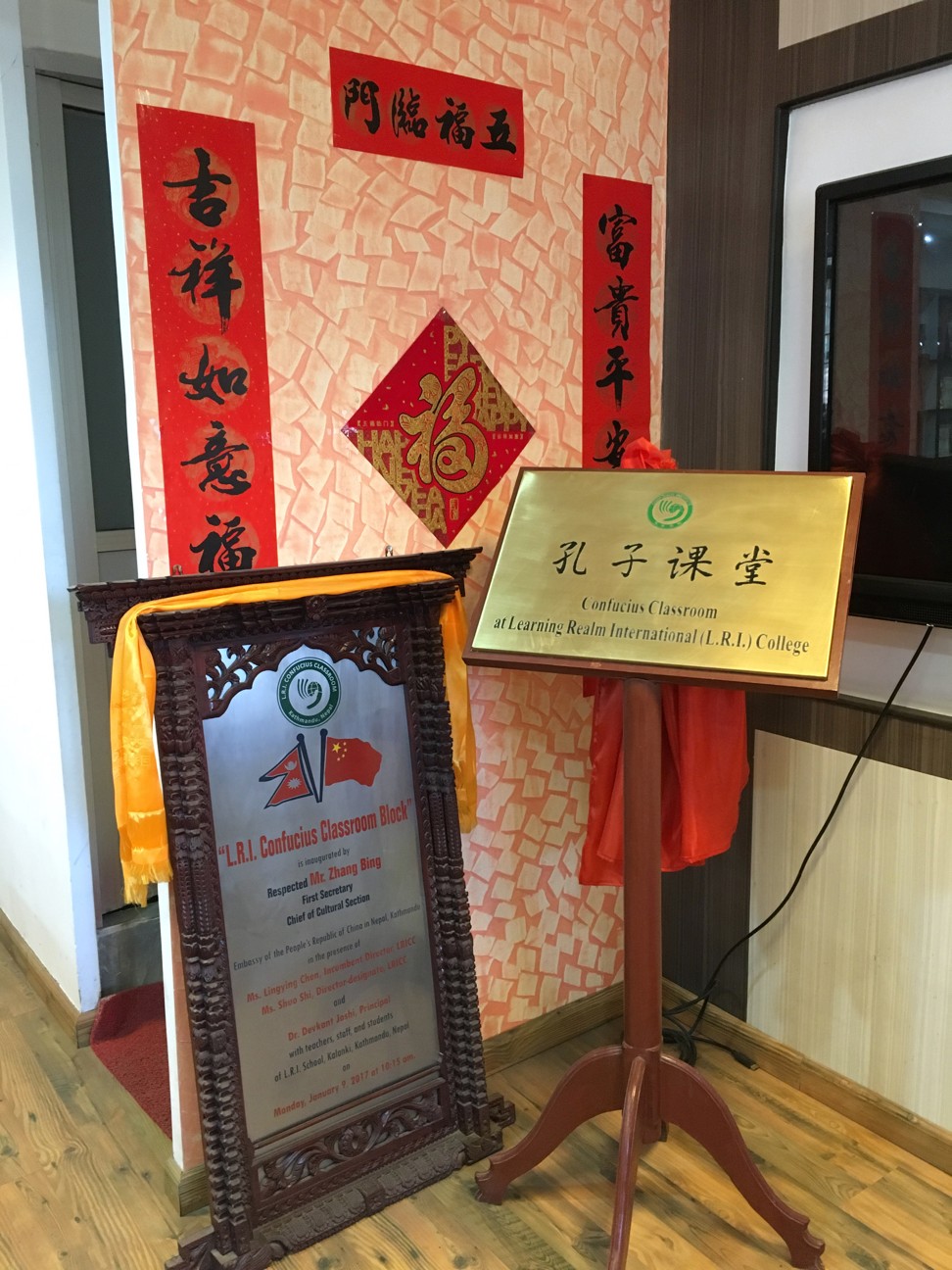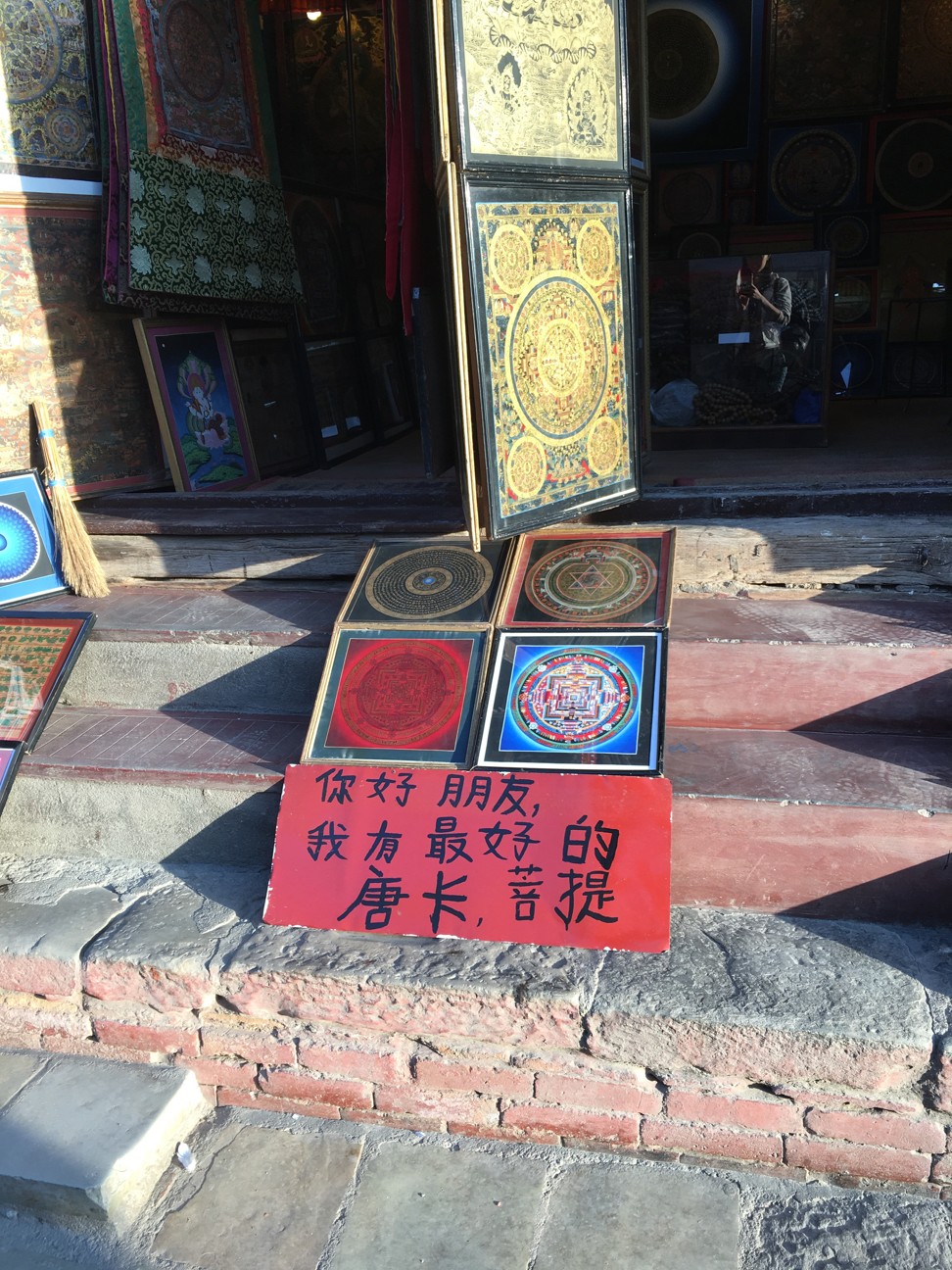
Is Nepal falling for China’s soft power charm offensive?
Mandarin lessons, orchestral performances and more than US$80 million of investment are helping Beijing to win hearts and minds in its tiny, but perfectly placed neighbour
The class of young schoolchildren in western Kathmandu, capital of Nepal, thought they were just learning some new Chinese words.
They were unaware that on that chilly Friday afternoon, the lesson being given by their teacher Lily Zuo was actually part of Beijing’s soft power charm offensive taking place across their country and around the world.
At the front of the Confucius Classroom at the Learning Realm International (LRI) School, Zuo held up a flashcard printed with the Mandarin character for “dog”.
“Gou,” she said, making a V-shape with her hand to show the fall and rise of the word’s tone.
“Gou,” the students echoed, their hands making smaller V’s.
About 1,600 youngsters take compulsory Chinese classes at the LRI school, in a sign of China’s increasing efforts to promote its language and culture in the Himalayan nation alongside its growing economic investments.
The Confucius Classroom – an educational initiative under the state-run Confucius Institute, which seeks to promote Chinese language and culture – was unveiled in 2011 by Liu Qi, then a member of the Politburo of the Communist Party of China, the country’s second-highest decision making body.
Much to the annoyance of New Delhi, Beijing has poured huge sums of money into infrastructure projects in Nepal – a landlocked nation with China to its north and India to its south – under its trade and infrastructure development plan known as the “Belt and Road Initiative”.
China is Nepal’s largest foreign investor, and in the past financial year alone has invested 8.36 billion Nepalese rupees (US$81.89 million) in the country, an increase of almost 35 per cent from the year before, according to Nepal’s Department of Industry.
While China’s cultural clout in the country still lags far behind that of India – with which Nepal shares a 1,700km open border – opportunities for Beijing to shift that balance were given a huge boost when Nepal’s Communist alliance, which is seen as friendlier to China, secured a landslide election victory.
The win was good news for China, given Nepal’s strategic location as a buffer with India and proximity to Tibet, an autonomous region of China with lingering tensions over its sovereignty.
“Right now, the most significant impression of China is the rise of China,” said Li Mingjiang, China programme coordinator at the S. Rajaratnam School of International Studies in Singapore. “That automatically generates a positive perception of China, and motivates … a lot of [Nepalese] people to intentionally understand China, study China, and even go to China.”
The impact of Chinese investment in Nepal is visible in its roads and motorways, hydroelectric projects and railways, as well as the rebuilding projects launched after the devastating earthquake of 2015 that left more than 9,000 people dead. At the entrance to a project, partly funded by Beijing, to restore a tower in front of the old royal palace in Durbar Square, are the flags of both Nepal and China.
This visible presence is a concern for India, which regards China as a strategic competitor and views the influx of Chinese money with a geopolitical edge.
There are also perennial concerns over China’s soft power regarding sovereignty, said Kingsley Edney, an international relations lecturer at the University of Leeds in Britain.
“Anyone in China’s neighbourhood is going to be aware of the gravity of China’s pull and the amount of influence it could potentially wield,” he said.
But many in Nepal appear unconcerned, focusing instead on China’s massive economic development and the spillover benefits it could have for their country.
This was what motivated the LRI School to introduce mandatory Mandarin lessons for all pupils from the third to seventh grades. Its Confucius Classroom is one of three in Nepal.
“We have to show them a road map for the future,” said principal Devkanti Joshi, seated near a wall covered in rows of chunlian – Chinese good luck couplets. “We visualise in the next 10 years time, 10 years down the road, Nepal’s economy will have largely benefited because of the Chinese economy.”
Pupils are also introduced to Chinese traditions, such as making sticky rice dumplings, or zongzi, for the Dragon Boat festival and eating mooncakes at the mid-Autumn festival. They are also taught about contemporary China, including the government’s claim that it is the home of the “four great new inventions”, including shared bicycles and high-speed railways.
“You can’t guarantee that all the pupils will enjoy Chinese, because of their individual interests, but in general, they seem to enjoy it,” said the 26-year-old teacher Zuo. “We want to be a window for them to better understand China.”
Although intended to act as a conduit for understanding China, Confucius Classrooms have sparked controversy in some countries because of their links to the Chinese government, and the perception that they support Beijing’s political objectives and fail to tackle sensitive topics. There are more than 1,000 such classrooms in primary and secondary schools around the world, with more than 100 in the United States alone.
“[Confucius Institutes] vary greatly in their effectiveness,” Steve Tsang, director of the SOAS China Institute in London, said. “In poor countries, with poor infrastructure for teaching anything to do [with] China or Mandarin, they are doing well.”
The primary source of soft power, however, was still “The China Model”, he said, which was “gaining currency or admiration in many parts of the world”.
Another government-backed initiative to promote Chinese culture in Kathmandu is the China Cultural Centre on Ring Road, the city’s orbital, which is being expanded with support from Beijing.
Since opening in 2015, the centre has organised dozens of events promoting Chinese culture, covering everything from a New Year concert by the Tianjin Symphony Orchestra to courses on conversational Mandarin and traditional Chinese medicine.
“There is still not that much understanding of China in Nepal,” Yin Kunsong, the centre’s director said. “We hope to tell China’s story to Nepal and the Nepalese people.”
Saroj Adhikari, a purchasing manager at a warehouse in Kathmandu, said he was among the first batch of people to study at the centre and had been “very interested” in Chinese culture ever since.
“As we all know, China is developing day by day,” he said. “It really helps us to learn about our best neighbour country.”
Another local man, Naveen Kafle, said he began studying Mandarin at the cultural centre about 10 months ago in the hope it would give him more opportunities.
“I was always optimistic about [the] China-Nepal friendship,” he said. “I am very happy now they are taking action to develop it.”
Another example of the growth of China’s soft power is the Xinzhi bookstore in Kathmandu – one of several the company has opened in the region. Taking pride of place just inside the door is a table laden with copies of The Governance of China, a collection of 79 speeches made by Chinese President Xi Jinping that is often touted by Chinese state media.
“We’re here to promote the Chinese language,” store director Xiang Pingyong said, as he poured a cup of hot tea. “Many locals come here to buy Chinese books. We also have teachers here to teach Chinese in the afternoon.”
The number of Chinese tourists travelling to Nepal is also swelling, rising 20 per cent in 2016 to 104,000, according to figures from the Nepal Tourism Board.
The sharp rise has coincided with an increase in the number of Chinese businesses in Kathmandu, including hotels and restaurants in the so-called Chinatown in the city’s Thamel district.
A Chinese businessman surnamed Xue, who runs an electronics company in Nepal, said he found it relatively easy to work in the city.
“There are more and more Chinese people here now,” he said with a grin. “I can get by just by speaking Chinese.”
Despite the smatterings of Chinese influence that can be seen across Nepal, Beijing still has some way to go, especially in the area of people-to-people relations, which are “still not sufficient”, according to Ishwor Pokhrel, general secretary of the recently victorious Communist Party of Nepal (Unified Marxist- Leninist).
“Cultural relations is the vehicle for strengthening bilateral relations,” he said. “Massively, we have to develop the people-to-people relations.”
That sentiment is very much in evidence at the LRI School, where a message board near their Confucius Classroom displays a poster that reads: “Long live the Nepal-China relationship.”
“Obviously we will benefit from the growing Chinese economy,” Joshi said. “We have that message very loud and clear.”








